The Easiest Homemade Rough Puff Pastry Dough Recipe Ever
Making a delicate homemade rough puff pastry dough can seem intimidating at first glance.
Professional bakers guard their secrets closely when crafting these buttery layers.
Our simple technique breaks down complex steps into manageable moments anyone can master.
Crisp, flaky textures emerge from careful folding and precise temperature control.
Cold butter becomes your greatest ally in creating stunning pastry sheets.
Each fold builds incredible depth and complexity in your dough.
Mastering this technique will unlock a world of delectable baked treasures waiting to surprise you.
Puff Pastry Dough That Delivers Flaky Perfection Every Time
Craft Homemade Pastry Magic: Reasons to Love This Recipe
Inside the Homemade Rough Puff Pastry Dough
Main Ingredients:Optional Ingredient:Rough Puff Pastry Dough Steps Without the Fuss
Step 1: Prepare Flour Base
Create a delightful foundation by mixing flour and salt in a spacious mixing bowl.
Ensure the ingredients are blended thoroughly, creating a smooth, even mixture.
Step 2: Incorporate Cold Butter
Toss cold butter cubes into the flour mixture.
Using a pastry cutter or your fingertips, break down the butter until the texture resembles coarse, bumpy crumbs with tiny butter bits scattered throughout.
Step 3: Add Liquid Ingredients
Create a small well in the center of the flour-butter mixture.
Gently pour in ice-cold water and a splash of lemon juice.
Carefully mix with a fork until the dough begins to come together, forming a shaggy, slightly sticky consistency.
Step 4: Form Initial Dough Ball
Transfer the dough onto a lightly floured surface.
Tenderly knead the mixture a few times, forming a rough, imperfect ball.
Be gentle and avoid overworking the dough, which could make it tough.
Step 5: First Folding Technique
Roll the dough into a rectangular shape approximately 1/2 inch thick.
Fold the dough into thirds, similar to folding a business letter.
This technique helps create delicate, flaky layers.
Step 6: Rotate and Repeat Folding
Turn the dough 90 degrees and roll it out again into a rectangle.
Repeat the folding process, creating more intricate layers that will result in a wonderfully flaky pastry.
Step 7: Chill and Rest
Wrap the dough carefully in plastic wrap and refrigerate for a minimum of 30 minutes.
This resting period allows the butter to firm up and the gluten to relax.
Step 8: Multiple Folding Rounds
Repeat the rolling and folding process 2-3 additional times, chilling the dough between each round.
Each fold increases the pastry’s flakiness and creates beautiful, delicate layers.
Step 9: Prepare for Baking
Your rough puff pastry is now ready to be transformed.
Roll it out to the specific thickness required by your recipe, and get ready to create mouthwatering pastries with a perfectly crisp, buttery texture.
Rough Puff Pastry Techniques to Nail Every Layer
Store Homemade Rough Puff Pastry Dough
Uses and Ideas for Rough Puff Pastry Dough
Rough Puff Dough Adjustments
FAQs
Rough puff pastry is easier and quicker to make, with less precise butter lamination. Unlike traditional puff pastry that requires extensive folding and chilling, rough puff uses a simpler method of folding and creates a similarly flaky texture.
Butter is recommended for the best flavor and texture. Margarine might not provide the same rich taste and may not create the desired flaky layers. Stick with cold, high-quality butter for the best results.
The butter should be very cold and straight from the refrigerator. Cold butter is crucial for creating visible butter pieces that melt during baking, resulting in those signature flaky layers.
Chilling allows the gluten to relax and the butter to firm up, which helps create distinct layers. This resting period prevents the butter from melting and ensures a more structured, flaky pastry.
Print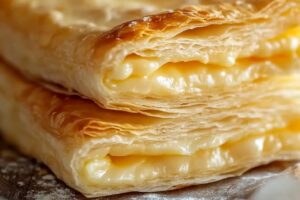
Homemade Rough Puff Pastry Dough Recipe
- Total Time: 45 minutes
- Yield: 8 1x
Description
Homemade rough puff pastry dough elevates baking with its buttery, flaky layers of deliciousness. Professional bakers and home cooks can master this simple technique to create mouthwatering pastries that impress at first bite.
Ingredients
Pastry Base:
- 2.5 cups all-purpose flour
- 1 teaspoon salt
- 1 cup unsalted butter (cold and cubed)
Liquid Ingredients:
- 0.5 cup (120 milliliters) ice-cold water (more if needed)
Flavor Enhancer:
- 1 tablespoon lemon juice (optional, helps with flakiness)
Instructions
- Create a powdery base by blending flour and salt in a spacious mixing vessel.
- Introduce chilled butter cubes into the flour mixture, then delicately fragment using fingertips or a pastry tool until the texture resembles rugged, uneven crumbs with butter particles scattered throughout.
- Create a shallow crater in the center of the flour-butter amalgamation, then cascade ice-cold water and optional lemon juice into the depression, gently coaxing the ingredients into a cohesive mass using a fork.
- Transfer the nascent dough onto a lightly dusted work surface, tenderly manipulating it with minimal kneading until a loose, imperfect sphere emerges.
- Metamorphose the dough into a rectangular shape approximately half an inch thick, then execute a precise tri-fold reminiscent of a business correspondence.
- Rotate the folded dough by 90 degrees, then methodically stretch it into another rectangular form, repeating the elegant tri-fold technique.
- Envelop the dough in transparent film and allow it to rest and chill within the refrigerator for a minimum of half an hour.
- Iterate the rolling and folding sequence an additional two to three times, ensuring thorough refrigeration between each transformation to enhance the pastry’s ethereal, flaky architecture.
- Upon completing the folding ritual, the pastry is primed for deployment, ready to be rolled to your desired thickness for culinary exploration.
Notes
- Cold butter is crucial for achieving those signature flaky layers in rough puff pastry, so keep ingredients extremely chilled throughout the process.
- Minimal handling prevents gluten development, ensuring a tender and light pastry texture that melts in your mouth.
- Work quickly and confidently when mixing and folding to maintain butter’s cold temperature and create distinct, beautiful layers.
- Store unused pastry dough wrapped tightly in plastic wrap inside the freezer for up to 3 months, allowing spontaneous baking adventures anytime.
- Prep Time: 15 minutes
- Cook Time: 30 minutes
- Category: Snacks, Desserts
- Method: Rolling
- Cuisine: French
Nutrition
- Serving Size: 8
- Calories: 250
- Sugar: 0 g
- Sodium: 140 mg
- Fat: 19 g
- Saturated Fat: 12 g
- Unsaturated Fat: 7 g
- Trans Fat: 0 g
- Carbohydrates: 21 g
- Fiber: 1 g
- Protein: 3 g
- Cholesterol: 30 mg

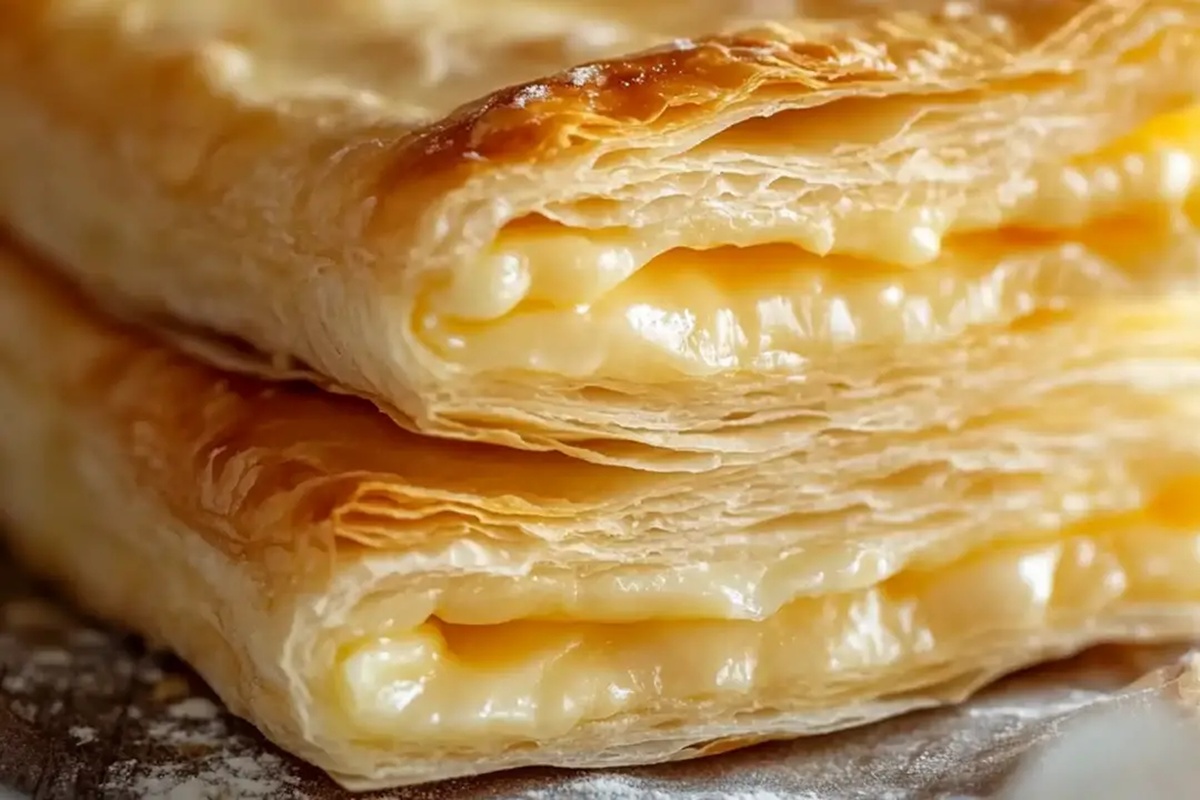
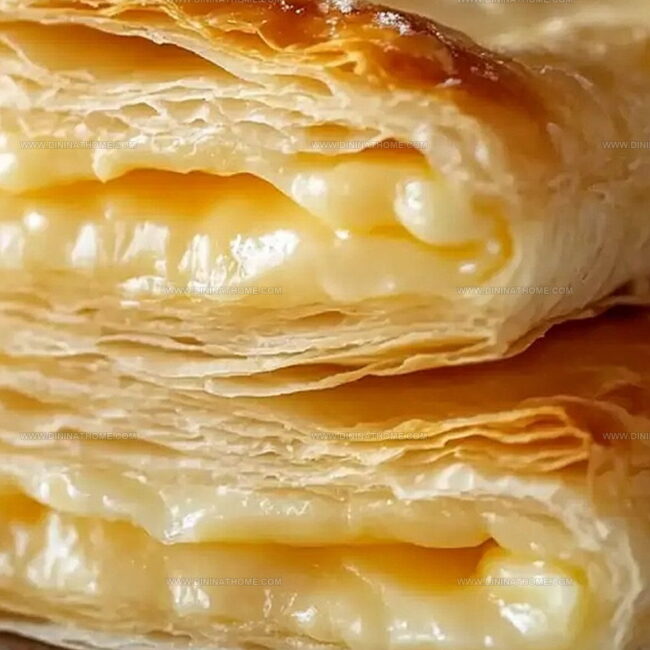
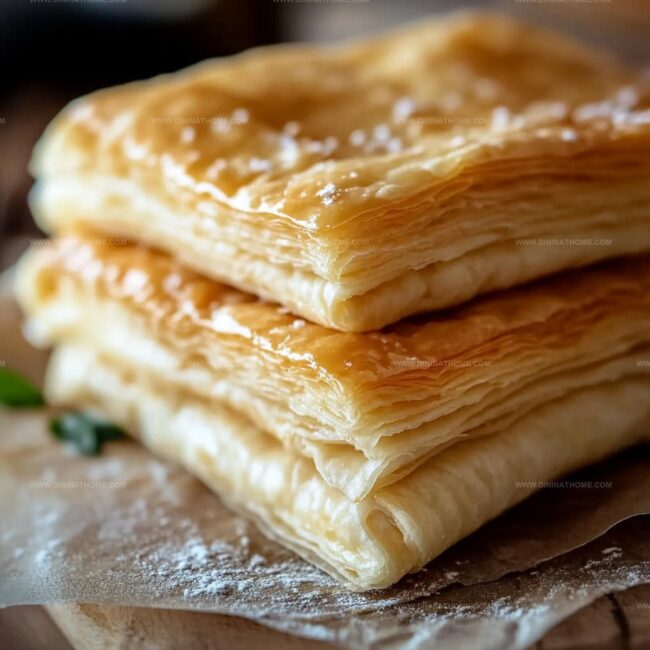
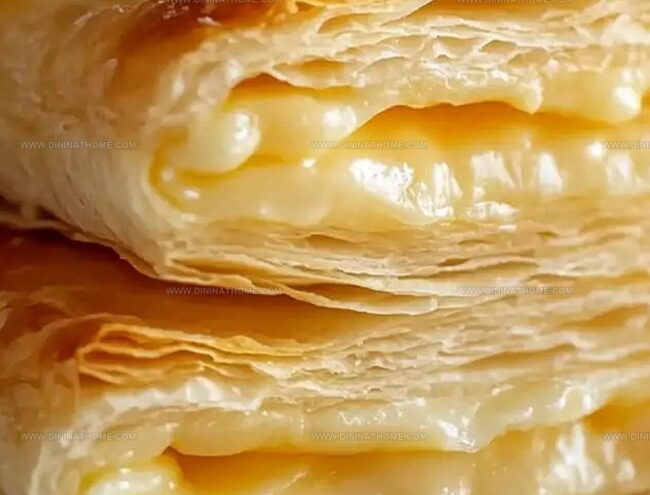
James Walker
Lead Recipe Developer & Culinary Educator
Expertise
Southern Cuisine & Farm-to-Table Cooking, Recipe Development & Testing, Culinary Education & Instruction
Education
School: Auguste Escoffier School of Culinary Arts
Program: Diploma in Culinary Arts and Operations
Focus: Comprehensive training in classical and modern culinary techniques, kitchen operations, and farm-to-table practices.
James didn’t learn cooking from a TV show, he learned it from busy kitchens, family gatherings, and long afternoons spent testing recipes the hard way.
After training at the Auguste Escoffier School of Culinary Arts, he brought his love for real, down-to-earth food to every dish he makes.
At Dining At Home, James loves building recipes that feel familiar but still have something special, like adding a twist to a classic or making a slow Sunday dinner feel brand new.
When he’s not in the kitchen, you’ll probably find him swapping garden tips at the farmers’ market or teaching his daughter how to flip pancakes without a mess (almost).